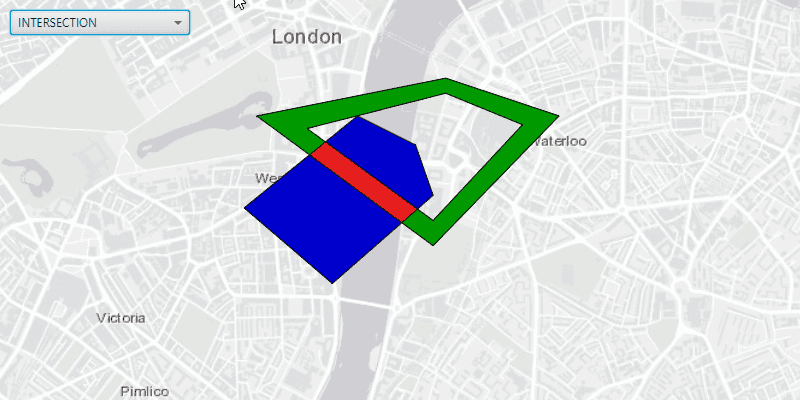Find the union, difference, or intersection of two geometries.

Use case
Determining the spatial relationships between points, lines or polygons is a fundamental concept in GIS. For example, a data analyst may need to find the intersection between areas with a high concentration of medical emergency situations and the service area of a hospital.
How to use the sample
The sample provides a drop down on the top, where you can select a geometry operation. When you choose a geometry operation, the application performs this operation between the overlapping polygons and applies the result to the geometries.
How it works
- Get the
Geometryof the features you would like to perform a spatial operation on. - Use the various static methods of
GeometryEngineto determine the spatial relationships between the geometries. For example, useGeometryEngine.intersection(polygon1.getGeometry(), polygon2.getGeometry())to find the intersection between two polygons.
Relevant API
- Geometry
- Graphic
- GraphicsOverlay
- MapView
- Point
- PointCollection
- SimpleLineSymbol
- SimpleFillSymbol
Tags
combine, difference, edit, intersect, intersection, modify, symmetric difference, union
Sample Code
/*
* Copyright 2017 Esri.
*
* Licensed under the Apache License, Version 2.0 (the "License"); you may not
* use this file except in compliance with the License. You may obtain a copy of
* the License at
*
* http://www.apache.org/licenses/LICENSE-2.0
*
* Unless required by applicable law or agreed to in writing, software
* distributed under the License is distributed on an "AS IS" BASIS, WITHOUT
* WARRANTIES OR CONDITIONS OF ANY KIND, either express or implied. See the
* License for the specific language governing permissions and limitations under
* the License.
*/
package com.esri.samples.spatial_operations;
import javafx.application.Application;
import javafx.collections.FXCollections;
import javafx.geometry.Insets;
import javafx.geometry.Pos;
import javafx.scene.Scene;
import javafx.scene.control.Alert;
import javafx.scene.control.ComboBox;
import javafx.scene.layout.StackPane;
import javafx.stage.Stage;
import com.esri.arcgisruntime.ArcGISRuntimeEnvironment;
import com.esri.arcgisruntime.geometry.Geometry;
import com.esri.arcgisruntime.geometry.GeometryEngine;
import com.esri.arcgisruntime.geometry.Part;
import com.esri.arcgisruntime.geometry.PartCollection;
import com.esri.arcgisruntime.geometry.Point;
import com.esri.arcgisruntime.geometry.PointCollection;
import com.esri.arcgisruntime.geometry.Polygon;
import com.esri.arcgisruntime.geometry.SpatialReferences;
import com.esri.arcgisruntime.loadable.LoadStatus;
import com.esri.arcgisruntime.mapping.ArcGISMap;
import com.esri.arcgisruntime.mapping.BasemapStyle;
import com.esri.arcgisruntime.mapping.view.Graphic;
import com.esri.arcgisruntime.mapping.view.GraphicsOverlay;
import com.esri.arcgisruntime.mapping.view.MapView;
import com.esri.arcgisruntime.symbology.SimpleFillSymbol;
import com.esri.arcgisruntime.symbology.SimpleLineSymbol;
public class SpatialOperationsSample extends Application {
private ArcGISMap map; // keep loadable in scope to avoid garbage collection
private MapView mapView;
private GraphicsOverlay resultGeomOverlay;
private Graphic polygon1;
private Graphic polygon2;
// geometry operations
private enum OPERATION_TYPE {
NONE, UNION, DIFFERENCE, SYMMETRIC_DIFFERENCE, INTERSECTION
}
// simple black (0xFF000000) line symbol
private final SimpleLineSymbol line = new SimpleLineSymbol(SimpleLineSymbol.Style.SOLID, 0xFF000000, 1);
@Override
public void start(Stage stage) {
try {
// create stack pane and application scene
StackPane stackPane = new StackPane();
Scene scene = new Scene(stackPane);
scene.getStylesheets().add(getClass().getResource("/spatial_operations/style.css").toExternalForm());
// set title, size, and add scene to stage
stage.setTitle("Spatial Operations Sample");
stage.setWidth(800);
stage.setHeight(700);
stage.setScene(scene);
stage.show();
// authentication with an API key or named user is required to access basemaps and other location services
String yourAPIKey = System.getProperty("apiKey");
ArcGISRuntimeEnvironment.setApiKey(yourAPIKey);
// initialise comboBox items
ComboBox<OPERATION_TYPE> geomOperationBox = new ComboBox<>(FXCollections.observableArrayList(OPERATION_TYPE
.values()));
geomOperationBox.getSelectionModel().select(OPERATION_TYPE.NONE);
geomOperationBox.setMaxWidth(180);
geomOperationBox.setDisable(true);
// handle ComboBox event to perform the selected geometry operation
geomOperationBox.setOnAction(e -> {
resultGeomOverlay.getGraphics().clear();
Geometry resultPolygon;
switch (geomOperationBox.getSelectionModel().getSelectedItem()) {
case UNION:
resultPolygon = GeometryEngine.union(polygon1.getGeometry(), polygon2.getGeometry());
break;
case DIFFERENCE:
resultPolygon = GeometryEngine.difference(polygon1.getGeometry(), polygon2.getGeometry());
break;
case SYMMETRIC_DIFFERENCE:
resultPolygon = GeometryEngine.symmetricDifference(polygon1.getGeometry(), polygon2.getGeometry());
break;
case INTERSECTION:
resultPolygon = GeometryEngine.intersection(polygon1.getGeometry(), polygon2.getGeometry());
break;
case NONE:
default:
return;
}
// update result as a red (0xFFE91F1F) geometry
SimpleFillSymbol redSymbol = new SimpleFillSymbol(SimpleFillSymbol.Style.SOLID, 0xFFE91F1F, line);
resultGeomOverlay.getGraphics().add(new Graphic(resultPolygon, redSymbol));
});
// create a map with the light gray basemap style
map = new ArcGISMap(BasemapStyle.ARCGIS_LIGHT_GRAY);
// enable geometry operations when the map is done loading
map.addDoneLoadingListener(() -> {
if (map.getLoadStatus() == LoadStatus.LOADED) {
geomOperationBox.setDisable(false);
} else {
Alert alert = new Alert(Alert.AlertType.ERROR, "Map Failed to Load!");
alert.show();
}
});
// create a map view and set the map to it
mapView = new MapView();
mapView.setMap(map);
// set a viewpoint on the map view centered on London
mapView.setViewpointCenterAsync(new Point(-14153, 6710527, SpatialReferences.getWebMercator()), 30000);
// create geometry overlays
GraphicsOverlay geomOverlay = new GraphicsOverlay();
mapView.getGraphicsOverlays().add(geomOverlay);
resultGeomOverlay = new GraphicsOverlay();
mapView.getGraphicsOverlays().add(resultGeomOverlay);
// create sample polygons
createPolygons();
geomOverlay.getGraphics().add(polygon1);
geomOverlay.getGraphics().add(polygon2);
// add the map view and control panel to stack pane
stackPane.getChildren().addAll(mapView, geomOperationBox);
StackPane.setAlignment(geomOperationBox, Pos.TOP_LEFT);
StackPane.setMargin(geomOperationBox, new Insets(10, 0, 0, 10));
} catch (Exception e) {
// on any error, display the stack trace
e.printStackTrace();
}
}
/**
* Creates the two intersecting polygons used in the application.
*/
private void createPolygons() {
// create blue (0xFF0000CC) polygon
PointCollection pointsPoly = new PointCollection(SpatialReferences.getWebMercator());
pointsPoly.add(new Point(-13960, 6709400));
pointsPoly.add(new Point(-14660, 6710000));
pointsPoly.add(new Point(-13760, 6710730));
pointsPoly.add(new Point(-13300, 6710500));
pointsPoly.add(new Point(-13160, 6710100));
SimpleFillSymbol fillSymbol = new SimpleFillSymbol(SimpleFillSymbol.Style.SOLID, 0xFF0000CC, line);
Polygon polygonSymbol = new Polygon(pointsPoly);
polygon1 = new Graphic(polygonSymbol, fillSymbol);
// create green (0xFF009900) polygon
// outer ring
PointCollection outerRingSegmentCollection = new PointCollection(SpatialReferences.getWebMercator());
outerRingSegmentCollection.add(new Point(-13060, 6711030));
outerRingSegmentCollection.add(new Point(-12160, 6710730));
outerRingSegmentCollection.add(new Point(-13160, 6709700));
outerRingSegmentCollection.add(new Point(-14560, 6710730));
Part outerRing = new Part(outerRingSegmentCollection);
// inner ring
PointCollection innerRingSegmentCollection = new PointCollection(SpatialReferences.getWebMercator());
innerRingSegmentCollection.add(new Point(-13060, 6710910));
innerRingSegmentCollection.add(new Point(-14160, 6710630));
innerRingSegmentCollection.add(new Point(-13160, 6709900));
innerRingSegmentCollection.add(new Point(-12450, 6710660));
Part innerRing = new Part(innerRingSegmentCollection);
PartCollection polygonParts = new PartCollection(outerRing);
polygonParts.add(innerRing);
fillSymbol = new SimpleFillSymbol(SimpleFillSymbol.Style.SOLID, 0xFF009900, line);
polygon2 = new Graphic(new Polygon(polygonParts), fillSymbol);
}
/**
* Stops and releases all resources used in application.
*/
@Override
public void stop() {
if (mapView != null) {
mapView.dispose();
}
}
/**
* Opens and runs application.
*
* @param args arguments passed to this application
*/
public static void main(String[] args) {
Application.launch(args);
}
}